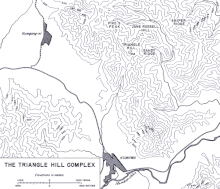| Battle of Triangle Hill | |||||||
|---|---|---|---|---|---|---|---|
| Part of the Korean War | |||||||
 Map of Triangle Hill area | |||||||
| |||||||
| Belligerents | |||||||
|
| |||||||
| Commanders and leaders | |||||||
|
|
Deng Hua Wang Jinshan[4] Qin Jiwei Li Desheng[5] Cui Jiangong | ||||||
| Units involved | |||||||
|
|
15th Corps[nb 2] 12th Corps | ||||||
| Strength | |||||||
|
Infantry: Unknown Artillery: 288 guns[8] Aircraft: 2,200+ sorties[9] |
Infantry: 50,000[10] Artillery: 133 guns, 24 rocket launchers AA Artillery: 47 guns[11] | ||||||
| Casualties and losses | |||||||
|
US: 365 killed 1,174 wounded 1 captured[12] South Korea: 1,096 killed 3,496 wounded 97 missing[13] Chinese estimate: 25,498[14] |
Chinese source: 4,838 killed 6,691 wounded[15] UN estimate: 19,000[16] | ||||||
The Battle of Triangle Hill, also known as Operation Showdown or the Shangganling Campaign (Chinese: 上甘岭战役; pinyin: Shànggānlǐng Zhànyì),[nb 3] was a protracted military engagement during the Korean War. The main combatants were two United Nations (UN) infantry divisions, with additional support from the United States Air Force, against elements of the Chinese People's Volunteer Army (PVA) 15th and 12th Corps.[nb 2] The battle was part of UN attempts to gain control of the "Iron Triangle" and took place from 14 October to 25 November 1952.
The immediate UN objective was Triangle Hill (38°19′17″N 127°27′52″E / 38.32139°N 127.46444°E), a forested ridge of high ground 2 kilometers (1.2 mi) north of Gimhwa-eup. The hill was occupied by the veterans of the PVA's 15th Corps. Over the course of nearly a month, substantial US and Republic of Korea Army (ROK) forces made repeated attempts to capture Triangle Hill and the adjacent Sniper Ridge. Despite clear superiority in artillery and aircraft, the escalating UN casualties resulted in the attack being halted after 42 days of fighting, with PVA forces regaining their original positions.
- ^ Chae, Chung & Yang 2001, pp. xi, 473.
- ^ Ministry of Patriots and Veterans Affairs 2012, p. 100.
- ^ Ministry of Patriots and Veterans Affairs 2008, p. 270.
- ^ Chinese Military Science Academy 2000, p. 568.
- ^ Chinese Military Science Academy 2000, p. 569.
- ^ Ministry of Patriots and Veterans Affairs 2012, p. 99.
- ^ Ministry of Patriots and Veterans Affairs 2008, p. 128.
- ^ Edwards 2005, p. 170.
- ^ Hermes 1992, p. 328.
- ^ Zhang 2010, p. 288.
- ^ Chinese Military Science Academy 2000, p. 304.
- ^ Ecker, Richard (September 2002). "Showdown on Triangle Hill: Twelve Days of Intense Combat in October 1952 Cost the U.S. 7th Infantry Division 365 KIA for a Piece of Turf that Ultimately Remained in Enemy Hands". VFW Magazine. Washington, D.C. Archived from the original on 11 June 2014. Retrieved 5 February 2009.
- ^ Chae, Chung & Yang 2001, p. 472.
- ^ Zhang 2010, p. 290.
- ^ Zhang 2010, p. 285.
- ^ Hermes 1992, p. 318.
Cite error: There are <ref group=nb> tags on this page, but the references will not show without a {{reflist|group=nb}} template (see the help page).